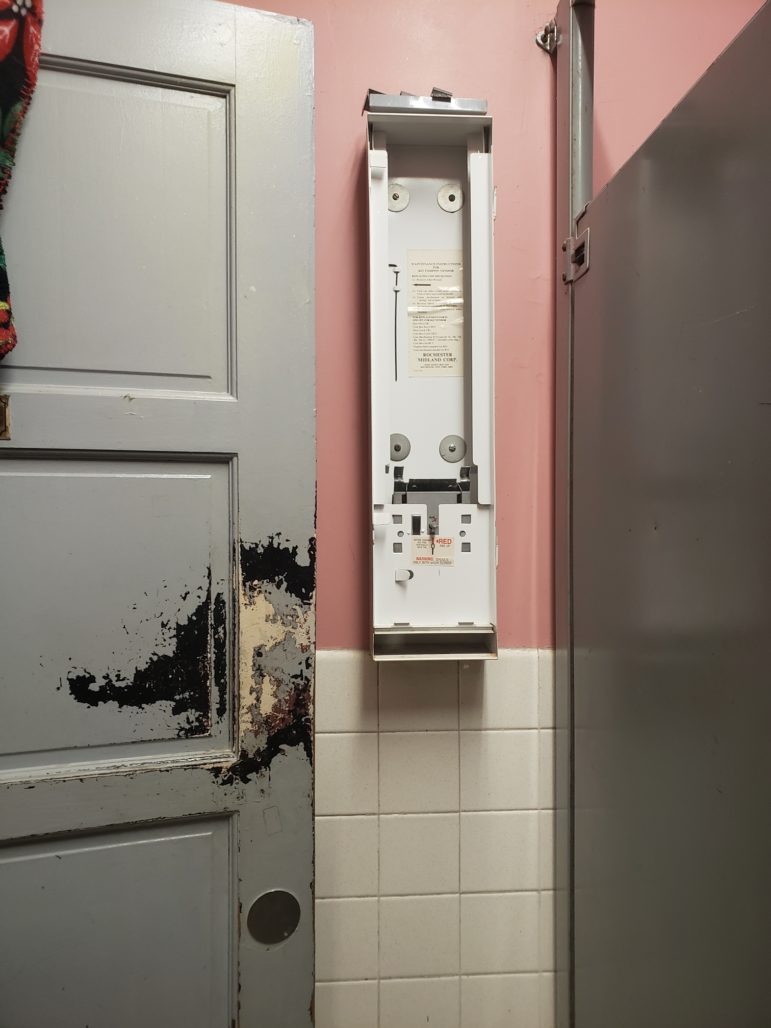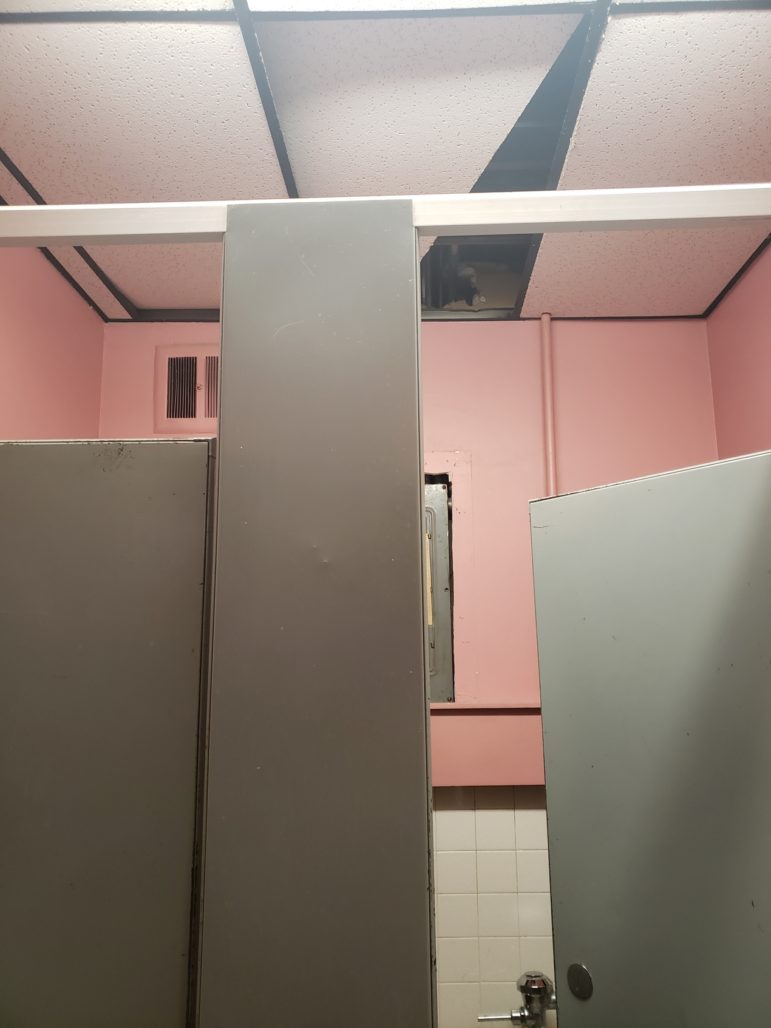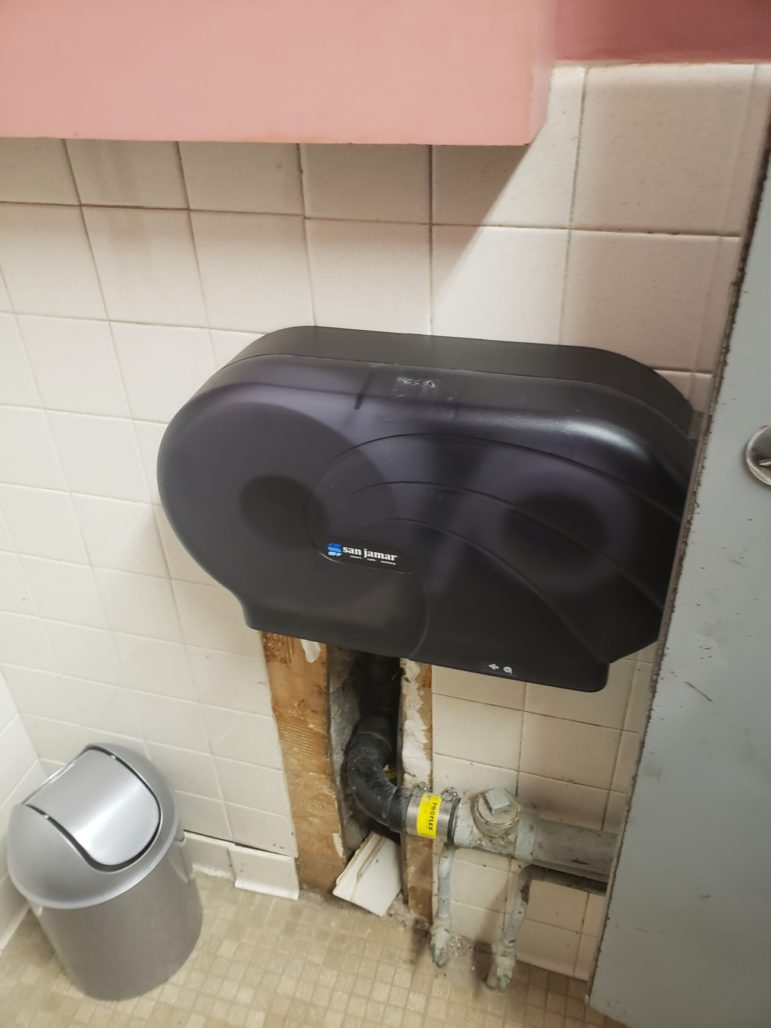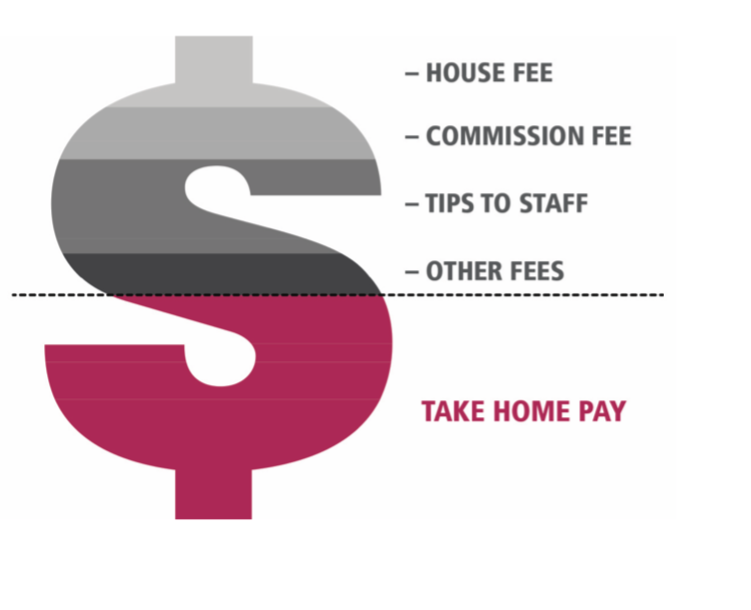
An isolated stripper pole on a stage lit by a single spotlight surrounded by crumpled up one dollar bill tips on a stripclub background

Share
Erotic dancers and sexual performers in Minneapolis have long languished under unhygienic working conditions.
“The bathroom in the locker room is always pink in color, musty, and falling apart. The tampon machine does not only not have tampons, but the entire cover is pulling off. Matching the paper towel machine and the broken hand dryer. The ceiling tiles are also out of place and lifted up, showing an endless black hole to nowhere.”
The scene described above is from Downtown Cabaret in Minneapolis from one anonymous dancer. This setting is common among various clubs.

Bathroom in a Downtown Minneapolis Strip Club 

For erotic dancers, working conditions encompass not only the dim lighting and persistent staleness of the stage area but also the lockers, changing areas and bathroom.
For these women, the work of building a sexual fantasy begins in hygienically compromised areas. Women transform into objects of desire while straddling the line between preserving their own personal safety and integrity and generating revenue from men that are encouraged to feel entitled to their bodies.
SexWorld offers enclosed glass booths where clients pay for women to perform erotic acts. It is common for customers to masturbate during the duration of the performance. One anonymous booth worker explained that patrons, “sometimes leave jizz and napkins on the floor and window and [staff] do not clean it in enough time, so customers are using dirty booths or are deterred.”
In an attempt to curb the hygienic lapses, specifically body fluids and health risks, the City of Minneapolis is currently in the process of passing an ordinance regulating adult entertainment establishments, with a focus on strip clubs. The motivation for the ordinance began in 2017 when Minneapolis health inspectors found bodily fluids in 11 of the 17 licensed adult businesses.
According to Minneapolis Council Member Cam Gordon’s website regarding the ordinance;
“It uses information gathered from two studies and several inspections that found unsafe, unsanitary and exploitative conditions in Minneapolis adult entertainment businesses. The studies included surveys of entertainers working in the establishments and meetings with worker representatives. The ordinance is an effort to protect the safety of workers and prevent them from being subjected to exploitation, discrimination or abuse. I have crafted ordinance changes in cooperation with entertainers to include stronger financial, health and safety protections.”
The Real Stripper Report was released in June 2018 and compiled through a Collaboration Between SWOP-Minneapolis, Minnesota State University, & Sex Workers Outreach Project – USA. Dr. Eric Sprankle, is an Associate Professor of Psychology at Mankato State University and Co-Director, of the Sexuality Studies Program. Along with MSU graduate students, Sprankle collaborated with SWOP-Minneapolis for the past two years, “on the design, data collection, and analysis of a needs assessment of workers in Minneapolis strip clubs.”
From Sprankle’s perspective, “the bulk of the ordinance is aligned with the results of our study, which if passed, in my opinion, will increase the well-being of workers in Minneapolis strip clubs.” The expectation is that the ordinance will continue to develop. Sprankle asserts that, “all future ordinances that affect workers in the sex industry should be worker-centered, where workers are involved in the creation, passing, and enforcement of the ordinances.”
The Real Stripper Report report also elaborates on other forms of workplace challenges. 40% of their 60 respondents “indicated that they have been hurt at work from physical structures (e.g., splinters on stages).” The report also named racial bias as a common concern, with “(63%) of participants report[ing] seeing or experiencing discrimination.”
The ordinance is the first of its kind for the city. University of Minnesota Graduate student Jayne explains,
I think what’s important and could easily get lost in this conversation is that this will be the first time the City of Minneapolis has attempted to pass any kind of municipal regulation that is specifically focused on trying to improve workplace conditions and the rights of workers in the adult entertainment industry.
The proposed ordinance would also address working conditions at the club prohibiting tip pooling and provide safety escorts when dancers finish their shift.
A report compiled by the University of Minnesota Urban Research and Outreach-Engagement Center (UROC) outlined a structure inside the clubs that breeds an environment that the entertainers describe as exploitative and harmful, including “economic exploitation by the club itself, pervasive verbal harassment and derogatory language, pressures to perform commercial sex acts, unwanted touching or groping, and sexual harassment and assault.”
The report explains that due to the high fees paid by dancers to the club there is greater pressure to steer their clients into the VIP spaces, to generate more revenue. According to the report, VIP spaces ”present a much higher risk for sexual violence and coercion.”
“They are secluded, private and often lack appropriate security. Customers expect more physical contact, rubbing, and grinding, sometimes to the point of ejaculation, because they are paying more money. Some clubs encourage a blurred line about enforcement of rules and what customers can expect due to price setting and general implications.”
Compounding the issue, dancers are treated as independent contractors who are limited in their ability to protect their economic interests. Attorney Tim Phillips has worked on a variety of lawsuits concerning the employment classification for erotic dancers. He notes that,
“Dancers are frequently misclassified as independent contractors instead of employees. When this happens, they are ineligible for unemployment and workers’ compensation benefits, they have to pay all their Social Security and Medicare taxes out of their own pockets, they are ineligible for healthcare coverage as an employee under Obamacare, and they have almost none of the workplace rights that employees usually have, such as a right to a minimum wage, overtime pay, sick pay, or meal or rest breaks.”
Club owners take deductions and fees as a condition of employment. Fees and deductions are convoluted and difficult to navigate. Dancers are encouraged or expected to tip out valets, DJ’s, “house moms”, etc.
For example, one anonymous dancer reported that while working three days at Choice Gentlemen’s Club, the owner claimed almost half of what she earned.
To break it down further, a 15 minute VIP dance cost the customer $200, and the owner deducted $75, leaving her with $125.
A half hour VIP dance cost $300. The owner took $125, leaving her with $175. For an entire Saturday night she might make $800, out of which the owner expects $300, leaving her with $500 not including the labyrinth of tip outs and house fees.
At Downtown Cabaret, one anonymous dancer stated that when she punches in for a morning shift,
“a fingerprint scanner pulls up the dancer by their name. Then amounts to show how much the house fee is. Since I got in at 12ish my house fee was $37. Then a receipt prints out for $7 when I actually paid $17 because there is a $17 fee included in the house fee for god knows what. I then get a receipt for $20 and head upstairs.”
This process is difficult to follow and understand for those both in and outside of the industry, leaving the payment process open to exploitation by predatory club owners

Some of the indignities dancers face are more subtle, but reinforce the lack of consideration for their comfort. Returning to the Cabaret:
The dressing room is an ugly “pink ladies” hue that has been stained with the unknown for too many years to count. There are two separate vanities with burnt out bulbs and hair straighteners still plugged into the wall. Full length mirrors are plentiful, however, the lockers are not. There are about sixty lockers available, all of which are in use, which means my bag is either out in the open, the house mom will watch it (if she is working), or I can put it downstairs at the check in desk with the counter girl. I hide it in a highlighter stained cabinet.
Eating can become a chore. Shifts can be long, and women aren’t allowed to leave for food. There is no fridge, limiting what can be brought, and the only food made available is, “over priced, fried club food.”
Similarly the same anonymous SexWorld worker notes that, “we are not allowed to leave during our six hour shift: not even to our car for lunch. I guess they assume we will fuck someone for money in the parking lot or something.”
The research and efforts by dancers to speak out has begun an important conversation around the workplace conditions for a category of workers that has been stigmatized and thus overlooked. One industry retailer described this sentiment in the UROC report.
“As a society, too, I feel like strippers are like, there’s the big judgment and so like, why— why take care of that [entertainers’ working concerns] because they deserve to be in a shitty work environment because you wouldn’t be there if you were a good person. Which is bullshit.”
According to Sprankle,
“The sex industry has been, and continues to be, viewed as an entity that needs to be controlled, confined, or even eradicated. It’s time to stop viewing the industry as a “vice” and as a law enforcement issue. Criminalization of sex work has only harmed workers, and those who are marginalized within an already marginalized industry (trans women of color, for example) are harmed the most. If the state is involved in the regulation of the sex industry, in any capacity, it needs to be worker-centered, worker-organized, and worker-led.”
The energy behind The Fight for $15 and the inherent abuses of prison labor has elevated the understanding that every worker deserves a structure that affords them self determination and dignity no matter their workplace. As contracted workers, erotic dancers operate in a structure that increases the likelihood of labor exploitation, harassement and sexual coercion. The proposed Minneapolis ordinance is a first step in treating their work with greater dignity and respect, shifting the public narrative from dancers as victims of sex trafficking and sexual exploitation to workers imbued with rights and deserving of our collective respect.
A public hearing on this ordinance will be Monday August 12th at 1:30 pm in the Minneapolis Council Chamber

